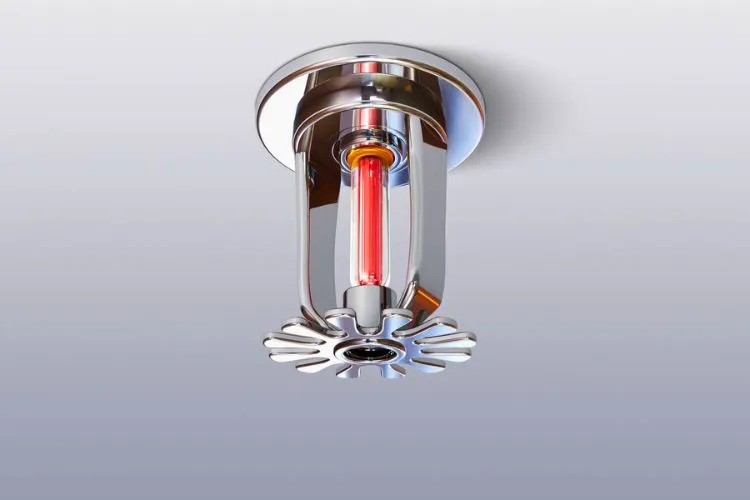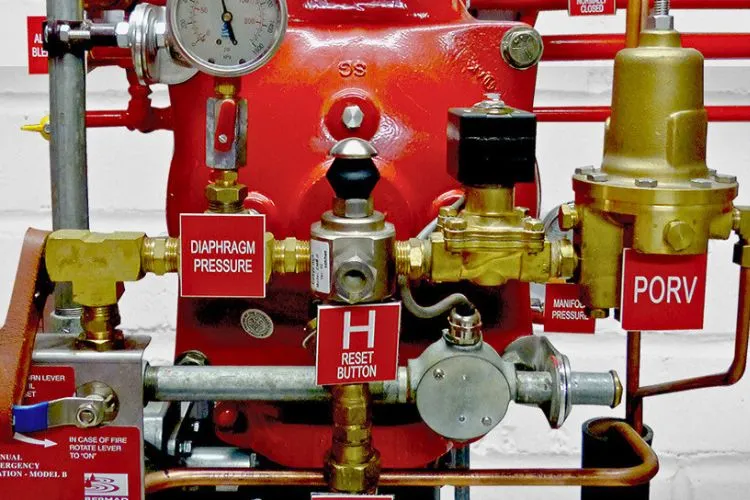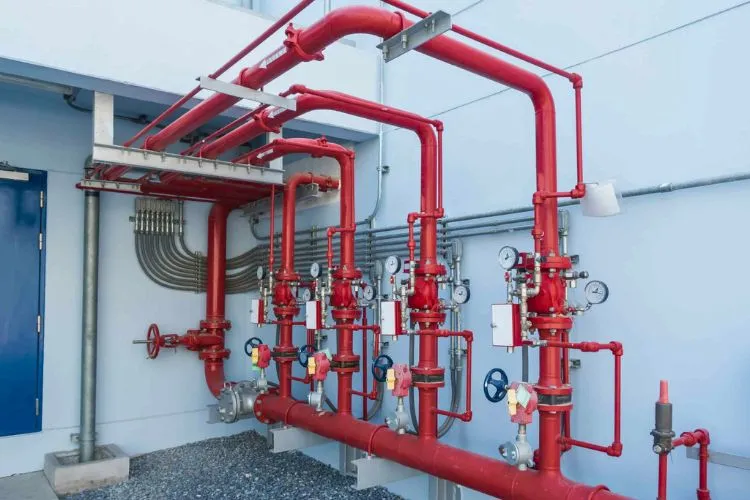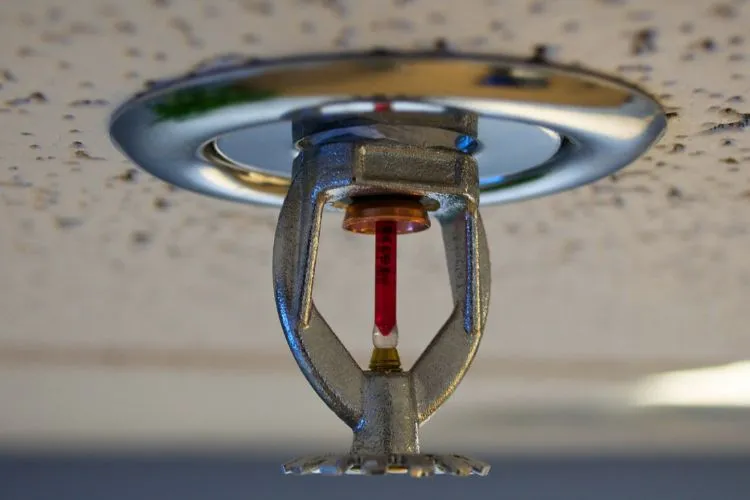The word ‘fire’ often brings to mind images of chaos and destruction. It’s a sight nobody wants to behold, especially in buildings and other structures where people often gather.
That’s where fire sprinkler systems come into play.
These sophisticated tools, often unseen until they spring into action, are essential for mitigating the damages caused by fires and offering everyone a better chance of getting out safely.
So, have you ever wondered, “how do fire sprinkler systems work?”

Well, let’s dive in and learn.
Key Components of Fire Sprinkler Systems
The secret to the fire-fighting property of sprinkler systems lies in their unique design. A fire sprinkler system primarily consists of sprinkler heads, a network of piping, control switches, and a water supply.
Sprinkler heads, attached to the piping, are equipped with heat-detecting sensors. These sensors have either a glass bulb or a fusible metal link that reacts when surrounding temperatures escalate due to a fire.
The piping forms an integral part of the system, filled with water under normal conditions and ready to deliver it to the sprinkler heads when necessary. Control switches, on the other hand, help manage the flow of water through the system.
Last but not least, water supply, either directly from the building’s water supply or from a dedicated fire water tank, provides the required water for the system to operate.
Types of Fire Sprinkler Systems
Fire sprinkler systems come in numerous types, each designed to serve a specific purpose. Among these, wet pipe systems, dry pipe systems, pre-action systems and deluge systems are common.
Wet Pipe Sprinkler Systems: The Constant Guardians
Wet pipe systems, as their name indicates, are constantly filled with water. These systems are predominantly used due to their prompt response.

In a wet pipe sprinkler system, when the heat-sensitive glass bulb or fusible link inside a sprinkler head reaches a specific temperature, it bursts, and the pressurized water in the pipes is immediately discharged onto the originating fire.
This system’s simplicity, reliability, and low maintenance requirements contribute to its global popularity in residential and commercial buildings.
Dry Pipe Sprinkler Systems: The Freeze-Proof Protectors
In stark contrast to the wet pipe variant, dry pipe sprinkler systems feature pipes filled with pressurized air or nitrogen instead of water. The water is held back by a control valve, which remains closed until a fire is detected.
Once activated, the pressurized gas is released, opening the valve and allowing water to flow through the pipes and out of the sprinkler heads.
This specific system is designed for environments that face freezing temperatures, like unheated warehouses or parking garages, where the water in wet pipe systems might freeze and block the system.
Pre-Action Sprinkler Systems: The Calculated Responders
Pre-action sprinkler systems represent a strategic blend of wet and dry pipe systems. Uniquely, they require a two-step process for activation. Initially, a separate fire detection system – such as a smoke detector – triggers the release of water into the piping system.

Subsequently, individual sprinkler heads operate like those in a wet pipe system, only activating in response to heat from a fire. This design is ideal for areas where unintentional activation could cause significant damage, such as data centers, museums, or libraries.
The initial triggering mechanism minimizes the chances of accidental water discharge, offering a calculated response to potential fire threats.
Deluge Sprinkler Systems: The Intense Extinguishers
Deluge sprinkler systems are specially designed for high-risk environments like power plants, chemical storage facilities, or aircraft hangers, where it’s essential to deliver a large volume of water rapidly.

Unique to deluge systems, the sprinkler heads remain open and are not individually activated. Instead, they spring into action simultaneously when a separate fire detection system is triggered.
Upon activation, water, foam, or a mixture of both is discharged throughout the entire system, providing comprehensive coverage and establishing a deluge to suppress intense fires.
how do fire sprinkler systems work?
What brings a fire sprinkler system to life during a fire is heat, not smoke. As heat rises and reaches the sensors in the sprinkler heads, the fusible link or glass bulb breaks, triggering the release of water.
Interestingly, only the sprinkler heads whose sensors are affected by the heat will respond, unlike the portrayal in movies where an entire sprinkler system is set off at once.
The water, under high pressure, is then directed onto a deflector. This deflector splits the water into a uniform spray pattern, designed to suppress the fire effectively by both cooling the fire and making the surrounding atmosphere less supportive for fire growth.
Benefits of Fire Sprinkler Systems
The immense benefits of fire sprinkler systems aren’t solely limited to extinguishing fires. They serve a major role in protecting properties and, most importantly, saving lives.
Fire sprinkler systems offer the first line of defense during the outbreak of a fire, combatting the flames at the source and preventing them from spreading.

They help protect properties and valuables from extensive damage, reducing both financial losses and recovery time. On a larger scale, sprinklers help in limiting the impact of fires on the environment.
When it comes to saving lives, sprinklers add crucial minutes to allow the safe evacuation of occupants before first responders arrive. They suppress fires effectively enough to create an environment less prone to the production of toxic fumes, thereby reducing casualties from smoke inhalation.
Frequently Asked Questions (FAQs)
How do fire sprinklers detect a fire?
Fire sprinklers use heat-sensitive elements, either a glass bulb or fusible link, which responds to the raised temperature caused by a fire.
What temperatures can activate a fire sprinkler system?
Generally, the activation temperature is around 68 degrees Celsius (155 degrees Fahrenheit), but it can vary depending upon the type of sprinkler and location installed.
Do fire sprinkler systems make use of smoke detection?
No, sprinklers are activated by heat, not smoke.
How often should fire sprinkler systems be inspected or maintained?
Regular maintenance is critical for the functionality of fire sprinkler systems. For the most part, a thorough inspection by a professional should be carried out yearly, with routine checks every six months.
Conclusion:
Understanding how fire sprinkler systems work is crucial to realizing the importance of effective fire safety measures. By promptly responding during the outbreak of a fire, sprinkler systems not only save lives but also protect properties, ensuring people’s safety and preventing potentially catastrophic losses.
Regular maintenance and professional servicing are essential to ensure these systems stay in optimal working condition, ready to safeguard lives and properties when needed the most.


